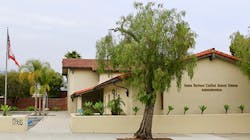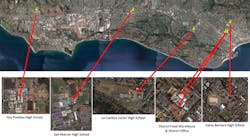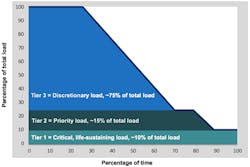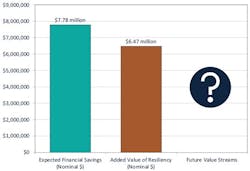Santa Barbara School District Launches Game-changing Solar Microgrids
Despite pandemic delays in U.S. microgrid deployments, the Santa Barbara Unified School District (SBUSD) Board in California unanimously voted in September to proceed with solar microgrids throughout the district, along with additional standalone solar projects. A state-of-the-art feasibility and request for proposals (RFP) process was a key factor in the win-win outcome for clean local energy and resilience. This paper discusses the processes that led to these showcase solar microgrids — and the unparalleled economic, environmental, and resilience benefits they deliver — which can be achieved by school districts and other entities anywhere.
Barriers to microgrids
In the first half of 2020, U.S. microgrid installations fell to their lowest point in four years, according to Wood Mackenzie. The slowdown was driven by the Covid-19 pandemic shelter-in-place and stay-at-home orders, which delayed permitting, construction and interconnection processes.
Even without a pandemic, a number of obstacles remain to deploying microgrids widely — many of them being outdated policies and market mechanisms that are misaligned with energy innovations like solar microgrids. Financing microgrids is also perceived to be an obstacle, with frequent questions like, “Who will pay for the microgrid?” The reality, however, is that financing is readily available once fair and transparent policies and market mechanisms are put in place.
The SBUSD solar microgrids show how to move forward in a straightforward manner. Even better, these solar microgrids serve as a model for school districts and other entities anywhere, including how to finance them in a straightforward manner that minimizes upfront costs and risks to the sites.
SBUSD project basics
The Clean Coalition, a California nonprofit, partnered with Sage Energy Consulting to help bring solar microgrids to the SBUSD. The district is located in the Goleta Load Pocket (GLP), a 70-mile stretch of Southern California coastline from Point Conception to Lake Casitas, encompassing the cities of Goleta, Santa Barbara (including Montecito) and Carpinteria. The area gets almost all of its energy from just one set of transmission lines hung on the same transmission towers and routed through 40 miles of mountainous terrain that is highly prone to wildfires, mudslides and earthquakes — making the GLP highly transmission-vulnerable.
The Clean Coalition and Sage Energy conducted extensive feasibility studies for 21 SBUSD schools and centralized facilities in early 2020, in May 2020 released a request for proposals (RFP) for 14 of those sites, and in September helped select the winning proposal, from Engie, which the SBUSD Board approved in a unanimous vote on Sept. 22. Engie will build, own and operate the proposed projects, with construction taking place before year-end 2021.
“This visionary initiative will result in a trifecta of economic, environmental and resilience benefits to the district,” said SBUSD Board President Laura Capps in a press release. “In addition, our schools with solar microgrids will have the ability to serve as places of refuge to the broader community, during grid outages of any duration. I am proud of the unanimous support that has been given to this effort across the district’s board, facilities staff, and former and current superintendents, as well as the support we have received from the community at large.”
Engie’s proposal comprises of 28-year power purchase agreements (PPAs), one for each of the 14 sites. There are six sites that will have robust solar microgrids, including battery storage, while all 14 sites have solar, entirely in the form of solar carports. All sites will be made ready for future electric vehicle charging infrastructure. In aggregate, there will be just under 5 MW of solar capacity and 5 MWh of energy storage.
The 14 sites include three high schools, four junior high schools, five elementary schools, a district office and a food warehouse with significant refrigeration loads. The solar microgrids will be deployed at the three high schools, one of the junior high schools, the district office and the food warehouse.
“The district’s solar microgrids have been strategically spread throughout the Goleta Load Pocket to best serve the entire community during grid outages, including those resulting from high-impact disasters,” said Steve Vizzolini, SBUSD director of Facilities & Modernization. “We will be positioned to support everything from emergency sheltering with food service to internet access and electronics charging stations.”
The game-changer: Value-of-resilience (VOR123)
With the groundbreaking SBUSD RFP, the Clean Coalition released innovative solar microgrid specifications that are based on the organization’s value-of-resilience (VOR123) methodology, which places a straightforward value on indefinite renewables-driven resilience.
The methodology normalizes the value-of-resilience between facilities by tiering loads into three categories, with the only difference between facilities being what percentage of load is represented by each tier. Advanced load management techniques ensure that the most critical loads (i.e., the most valuable loads) are maintained indefinitely, while other loads are toggled based on priority and energy availability:
- Tier 1: Mission-critical, life-sustaining loads that warrant 100% resilience — usually about 10% of a facility’s total load. At the SBUSD, Tier 1 loads are freezers and refrigerators. The RFP specifies that these loads must be kept operational 100% of the time, even during grid outages of any duration.
- Tier 2: Priority loads that should be maintained as long as doing so does not threaten the ability to maintain Tier 1 loads — usually about 15% of the total load. At the SBUSD, Tier 2 loads include communications systems and emergency staging facilities, including for emergency sheltering. The RFP specifies that during grid outages, Tier 2 loads must be kept online at least 80% of the time.
- Tier 3: Discretionary loads that should be maintained only when doing so does not threaten Tier 1 and Tier 2 resilience — usually about 75% of the total load. At the SBUSD, during grid outages of any duration, Tier 3 loads are anticipated to be kept online approximately 25% of the time.
The Clean Coalition has determined that a site should be willing to pay 25% more for its electricity for the benefits of indefinite solar-driven backup power to Tier 1 loads, along with solar-driven backup for Tier 2 loads a majority of the time and for Tier 3 loads a significant percentage of time as well.
However, the SBUSD will get this added resilience benefit for free — in addition to saving millions on their electric bills via the fixed-rate, 28-year PPAs. Future value streams, from yet-to-be implemented market mechanisms, provide further economic upside to the dispatchable solar energy that will become available to the district.
The process and the players
The path to arriving at this groundbreaking RFP began in 2018. Following the devastating December 2017 Thomas Fire in the area, and the subsequent January 2018 debris flow, the Clean Coalition conducted extensive outreach in the GLP that raised the visibility of the need for resilience in this disaster-prone region — as well as the value of this resilience.
Based on an understanding of this need, in late 2019, a high-profile member of the Santa Barbara community contacted the SBUSD’s superintendent to encourage a collaboration with the Clean Coalition to get solar microgrids at the SBUSD’s many schools and other sites. The SBUSD and the Clean Coalition then initiated discussions that led to the SBUSD releasing an RFP in May 2020 to contract for Solar Microgrids via PPAs.
The full process that was conducted by the Clean Coalition, and its partner Sage Energy, includes the following steps:
1. Preliminary Feasibility Review
This is a high-level assessment to establish a conceptual project, provide high-level siting of potential systems and establish preliminary financial results to assess the feasibility of a project. This task involved project kick-off activities such as establishing project goals and collecting site data, as well as performing the Preliminary Feasibility Review of all SBUSD sites. The project kick-off was designed to establish a working relationship and facilitate information sharing. Distributed energy resource (DER) and microgrid projects, in particular, can be very complex and require that all stakeholders be aligned on project goals, understand the key outcomes and be equipped to make decisions related to the project.
2. Investment-Grade Feasibility Study and Microgrid Resilience Analysis
○ The Investment-Grade Feasibility Study involved comprehensive site visits, collecting detailed information about current and future energy usage and site development, and working with stakeholders to confirm goals, define design requirements and use cases and set expectations for the project.
○ The Microgrid Resilience Analysis involved working with stakeholders to confirm goals, define design requirements and use cases, and set expectations for the resilience aspects of the project. Also included was performing a preliminary analysis and investigating initial system sizing, operations and economics using the Clean Coalition’s VOR123 methodology; this involved working closely with the district to define Tier 1, Tier 2 and Tier 3 loads at each SBUSD site.
3. RFP preparation and procurement management
This step involved creating an RFP per California Government Code 4217 to select a proposal that, at the very least, would provide economic savings to the SBUSD. It also included administering the entire RFP process.
4. Vender selection
Vendor selection involved screening the initial proposals, performing detailed analysis of the proposals, interviewing short-listed proposers and recommending the best proposals to the SBUSD staff for final selection, followed by unanimous approval by the SBUSD Board.
5. Contracting support
This final step included facilitating the contract kick-off and negotiation meetings with the SBUSD, legal counsel and the selected developer. It also involved assisting with contract negotiations and contract redlines with legal counsel, refreshing estimates of project financial and environmental performance, and preparing necessary contract approval findings.
The SBUSD has shown impressive leadership in unanimously voting to move forward with this groundbreaking initiative. The associated solar microgrid specifications introduced significant innovations that guarantee resilience benefits to the district and are game-changing for the industry. The SBUSD solar microgrids serve as a model that can easily be followed by school districts and other entities throughout the country — and well beyond.
Going forward
Contract negotiations with Engie are currently in the final stage, with contract approval expected by the SBUSD Board in November. Permitting processes will begin soon after the board approval, followed by construction that is targeted for completion in the coming summer. All construction is anticipated to be complete by year-end 2021.
As news spreads about the game-changing SBUSD solar microgrids, more school districts, as well as other entities, are initiating similar investigations. An example of the news spreading can be found in Generation 180's Brighter Future Report, which includes a section on the SBUSD project and highlights the fact that schools can deploy solar, and even solar microgrids, at no upfront cost — and enjoy millions in economic savings and free additional value-of-resilience.
About the Author
Craig Lewis
Craig Lewis is the founder and executive director of the Clean Coalition. He has over 30 years of experience in the renewables, wireless, semiconductor, and banking industries. Previously VP of government relations at GreenVolts, he was the first to successfully navigate a solar project through California’s Renewable Portfolio Standard solicitation process. Craig was energy policy lead on Steve Westly’s 2006 California gubernatorial campaign. His resume includes senior government relations, corporate development, and marketing positions at leading wireless, semiconductor, and banking companies such as Qualcomm, Ericsson, and Barclays Bank. Craig received an MBA and MSEE from the University of Southern California and a BSEE from the University of California, Berkeley.





